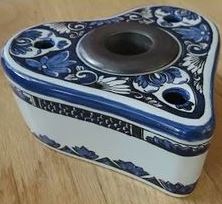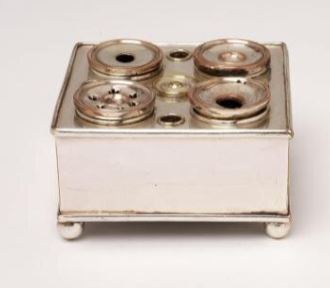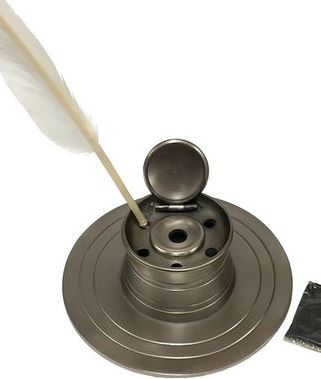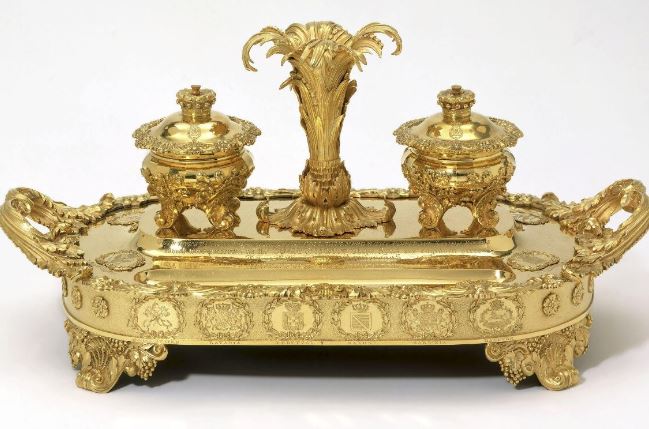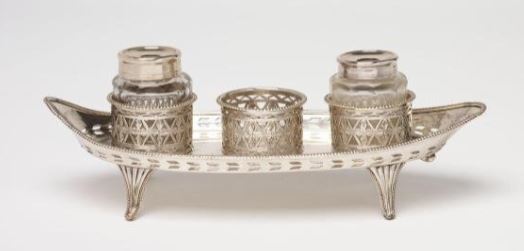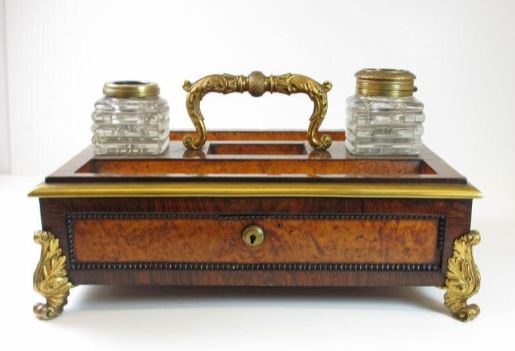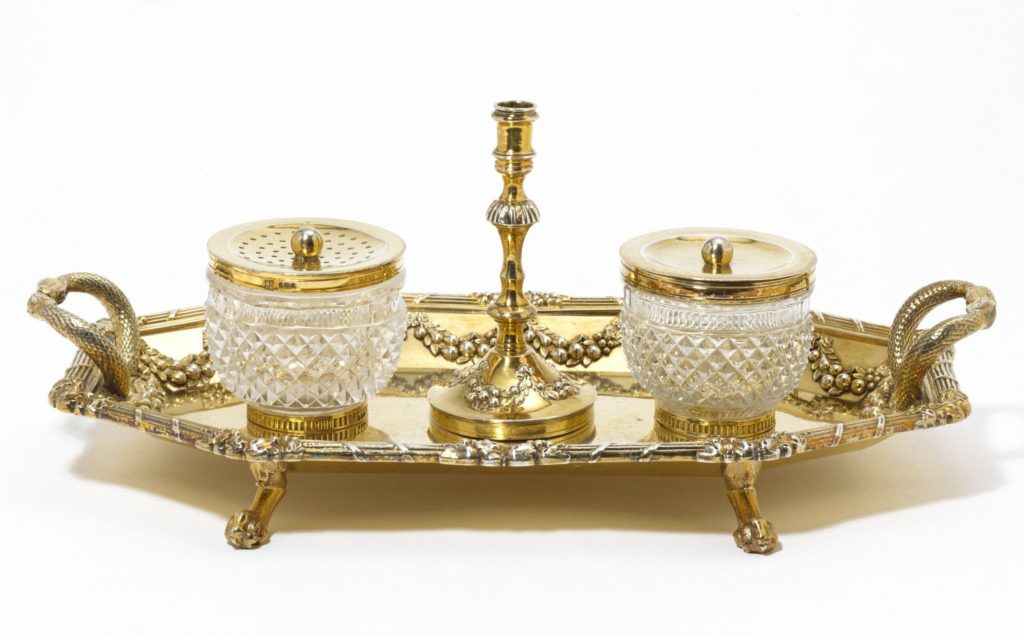My curiosity was piqued recently when a friend sent me photos of an 18th century room in Williamsburg, VA that included a desk displayed as though someone had just left it. On it was a beautiful Delftware ceramic inkwell/penholder. Delftware?
I’d just been writing a scene where one of my Regency characters was writing letters at her writing table, and without mentioning them I’d pictured glass inkwells in brass, silver or other types of metal stands. Blue & white ceramics? Not so much. Or ceramics at all, for that matter. I hadn’t given any of it much thought, so down the rabbit hole I went and now invite you to follow!
What sort of “furnishings” would one of our Regency main characters have had on a working office desk, or a letter writing table, or a desk in their well-appointed library? If you add blotters, sand, sealing wax apparatus, quills, pen knives, etc., not to mention a lamp or candle stand–well, with all of that, how large a desk might one require to still have space enough to work? What exactly made a desk “elegant” as opposed to merely serviceable?
We writers use the details of everyday life to help illuminate our characters, their lifestyle, social status and wealth. The amazing variety available in desk furnishings seems to me a wonderful opportunity to do that, and more. The character’s own taste, whether or not their desk was located in view of other “judge-y” people (as my son calls them) and whether those people were social guests, tenants or business associates all might factor in what objects resided there. Whether these possessions had come down from previous generations or been replaced by more up-to-date pieces, whether the items were treasured or purely practical all are variables in the choices we might make.
Desk sets (generally known as encriers, inkstands, pen trays, or standishes) answered the space problem with typical period ingenuity, combining several functions into one item. They varied not only in what materials were used and how elaborately they were designed, but also in what writing equipment they included.
Eighteenth century or earlier sets often included two inkpots, a pounce pot, a quill holder, candlestick and snuffer/wick-trimming scissors, all on a tray. These might be grouped around a central carrying handle for portability. Some sets also included a storage box for sealing wafers, a bell to summon servants, and even storage for pen knives, extra quills, etc.
(Courtesy of V&A Museum: square inkstand of Sheffield plate featuring two inkpots, a pounce pot and pot for wafers, with two quill holder openings)
If you were suddenly transported back to the Regency era and landed at someone’s desk, would you know what to do with all of these items? Sealing wax was the preferred method for the upper crust to secure a letter, and a method to heat it was necessary. Hence, a chamber stick or taper had two purposes, to give light and also to melt wax. Wafers, a more mundane way to seal a letter, did not require that extra equipment. The pounce pot contained fine sand that would be sprinkled lightly on a finished letter or other document to absorb extra ink and help prevent smudges. Pen knives were essential for trimming and reshaping the point on one’s quill when it wore down. The inkwells themselves were usually made of glass or porcelain and set inside the compartments or holders.
Consider this high-end Georgian silver set (below) dated to 1744: the rectangular tray with elaborate scroll-work edges features two oblong pen troughs and three circular wells into which fit an inkpot/quillstand, chamber-stick, and pounce pot. Besides the shells and other decorative motifs, the tray and both pots are engraved with the owner’s heraldic crest. Very elegant, and note: no wafer box with this set.
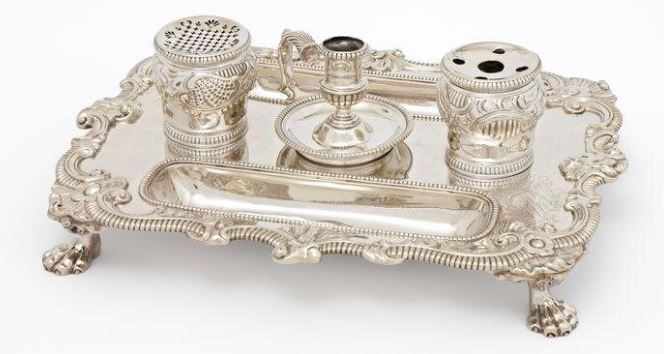
Author Joanna Waugh has a fascinating blogpost about the social significance of using wafers versus sealing wax here: (https://herreputationforaccomplishment.wordpress.com/2015/08/27/wafer-etiquette/)
I can imagine that anyone as elevated as the former owner of this silver set, with its engraved heraldic crest, probably never deigned to use wafers on any correspondence handled personally.
Of course, the range in inkstands goes from the bare minimum if you had just enough money to need and have a desk to these top-of-the-line sets, and everything in between, with various levels of embellishment. The minimum: a pewter inkwell/quill stand.
At the other end? Consider this solid gold inkstand below (1817-1819) made by London jewelers Rundell & Bridge* for Lord Castlereagh after the treaties that ended the Napoleonic Wars. It was created out of the gold from 21 snuffboxes gifted to him by the representatives of all the delegations involved in the treaties, whose emblems decorate the base.
(Courtesy V&A Museum, used by permission) *For an article about this famous jewelry firm’s work for the British Crown, see: https://www.rct.uk/collection/people/rundell-bridge-rundell#/ )
In between, those aspiring to elegant appearances perhaps beyond their means had the option of choosing Sheffield plate which had been invented in the 1740’s. The process of bonding thin layers of silver on either side of a copper base and rolling it out as a thin metal sheet made “silver” goods available to a much wider market –the slowly emerging middle class. Machines such as the fly press for pierced work and steel dies to stamp designs on sheets of Sheffield plate or silver sped up production, which lowered costs as well.
Styled very much like higher-end sets made from silver, this Sheffield plate set above features pierced design work on the wells for glass ink pot and pounce pot, plus candle holder, on a boat-shaped footed pen tray.
This set below is also made from Sheffield plate with typical pierced designs, and the three pots made from blue glass.
Many other quite high-end inkstands or encriers were made from a variety of materials such as bronze, or rosewood with brass inlaid designs, and in a variety of shapes. The Russians started a fashion for gilded inkstands with bases made from malachite with its distinctive green color. Some online auction houses have sold period sets for quite high sums, but you can find many pictures of examples, and since I can’t include them here, I urge you to take a look. I have found the most at 1stdibs.com: https://www.1stdibs.com/furniture/decorative-objects/desk-accessories/inkwells/style/regency/
This one (dated 1800-1840) in the V&A Museum has fancy wood veneers and cut glass bottles:
This handsome set also in the V&A Museum is described as “silver gilt”and the ink and pounce pots are cut glass:
Many other styles incorporate statuary of various sorts including animals and classical figures. One of my favorites at an auction house site has a greyhound standing on top of the wafer box.
Meanwhile, those pretty blue & white Delftware sets would have been considered very old-fashioned by the Regency period. Most seem to date from 1674-1767 and probably would have been relegated to the attics unless a character loved one that belonged to a grandparent, or was too impoverished to replace an old family piece or gift with something more current.
I could see a child becoming engaged with one as charming as this example below (L) from the Winterthur Museum Collection (dating 1761-1769), however, and as an adult later remembering a grandparent with fondness when using it at their personal writing desk. Or one like this very simple ceramic inkwell (R) from the Smithsonian museum collection. (photos used by permission).
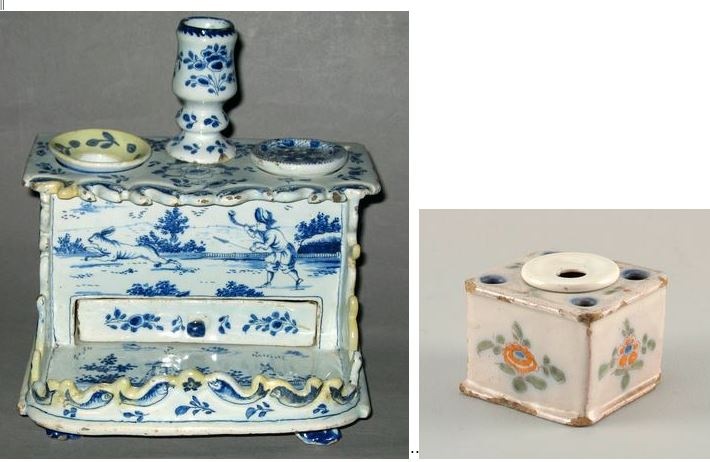
But do not think ceramic sets went out of style altogether! Below is a beautiful example made by Chamberlain & Co., Worcester, ca. 1800: inkstand and cover crafted with a pen tray at the front, inkwell and pounce-pot of porcelain painted with enamels and gilded, in imitation of Japanese Imari ware. (courtesy of V&A Museum, used by permission)
And this inkstand with taper stick c. 1820, also in the V&A Museum, shows the taste for Japanese decoration lasted: “Inkstand with two detached inkwells and covers of bone china painted with enamels and gilded, Spode Ceramic Works, Stoke-on-Trent.” While it doesn’t show very well in the photo, there is a trough at the front for a pen rest.
I will definitely be giving some thought now to what sort of inkstand might be on my character’s writing table. I think a porcelain one like either of these might suit her very nicely—elegant, beautiful, yet distinctive.
So what would you choose to have on your desk if you were the main character (MC) in a Regency romance?
(Note: Photos without credit specified are public domain or courtesy of the V&A Museum)


